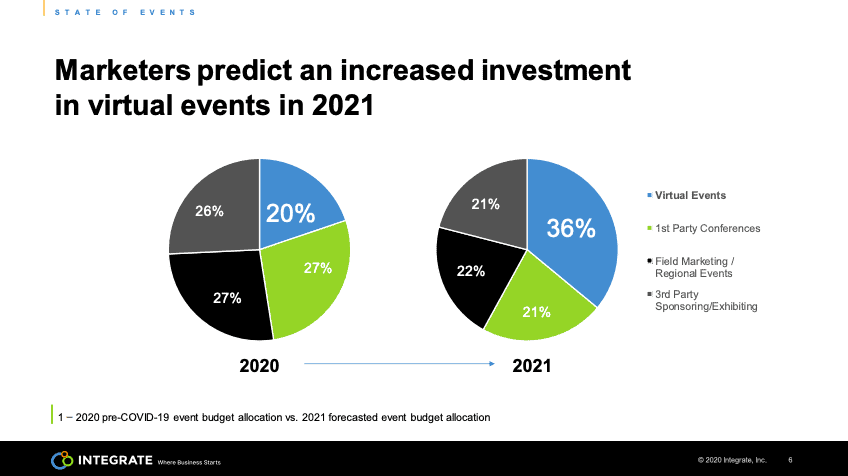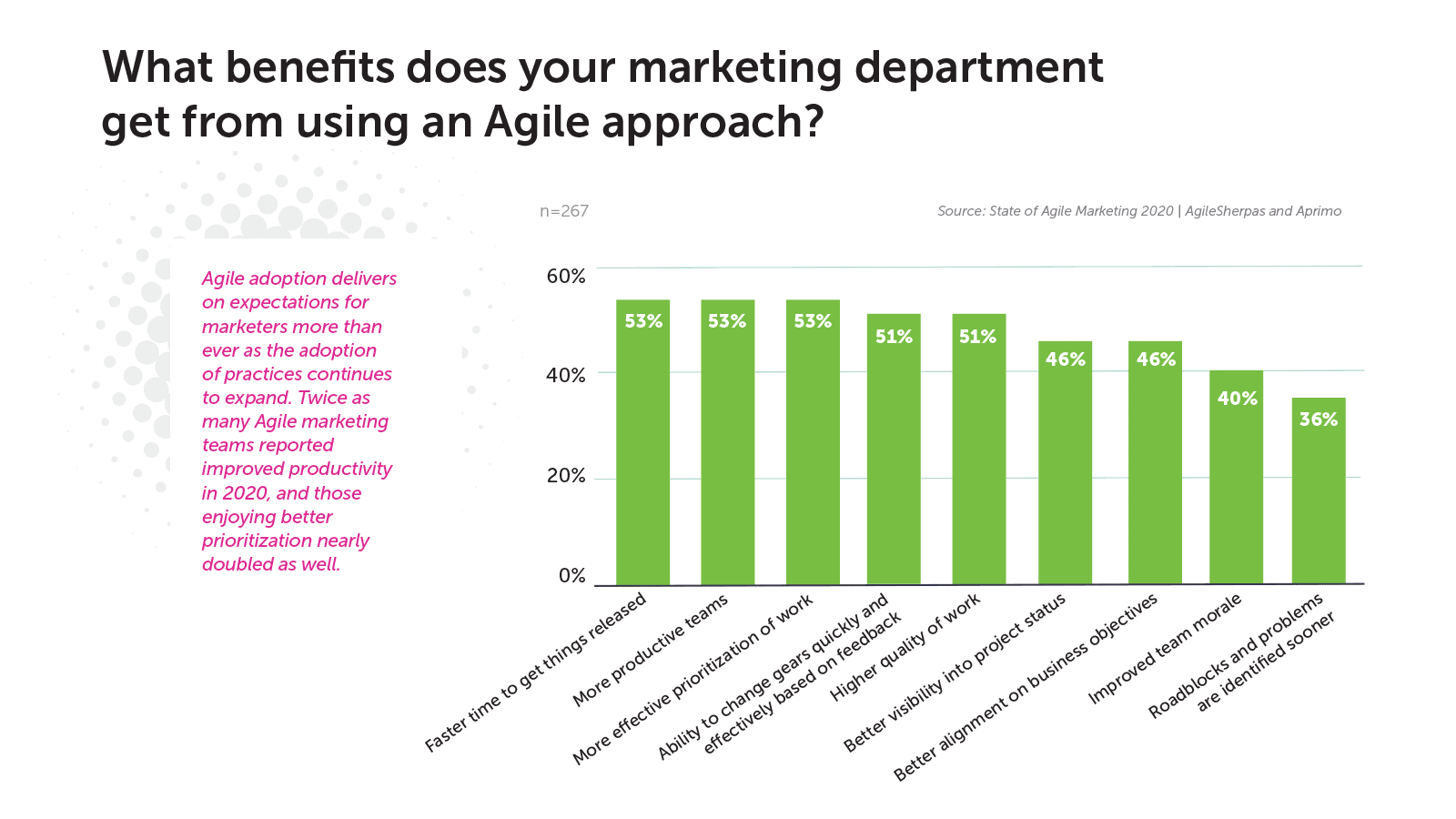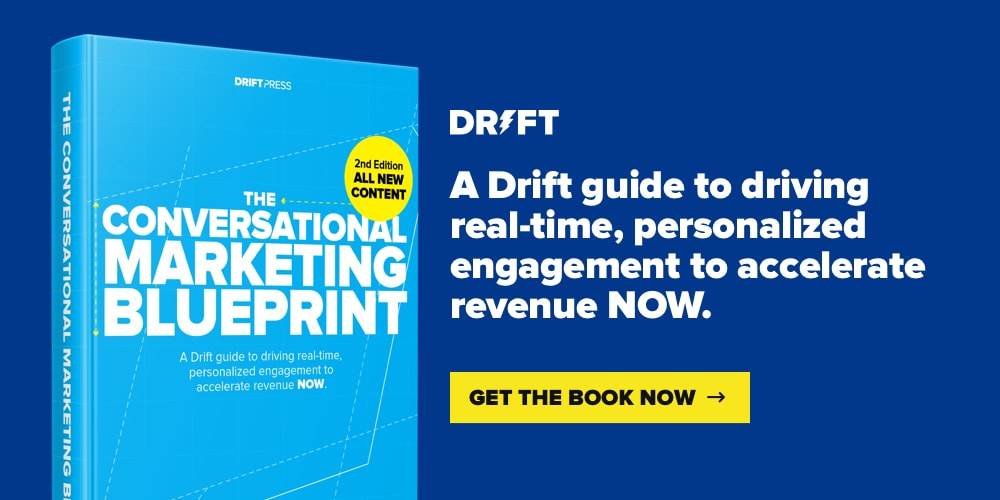If 2020 taught marketers anything, it’s that we were no longer standing “at the edge of digital transformation.” Instead, we were dropped unceremoniously into the middle of it. And now, whether we like it or not, there’s no turning back.
The rapid shift to a digital-only world has forced modern marketers to adapt quickly. In fact, a recent McKinsey survey found that in response to COVID-19, the adoption of digital technologies has been accelerated by several years.
But, despite the fact that many of us are overjoyed to see 2020 in the rearview mirror, don’t expect the lessons we’ve learned as a marketing community to go anywhere anytime soon. The unfortunate truth is this: organizations that fail to embrace this digital transformation will struggle to keep up in 2021.
So, what tactics and trends should you keep in mind in the new year? Barring any unexpected global phenomena, here’s what you can expect to see.
1. Virtual Experiences Are Here to Stay 💻
This year, as quickly as in-person events were shut down, we saw virtual events and experiences take off. Not only did we see more virtual events than ever before, but we also saw a drastic change in the quality of these events. Marketers invested more time and money into their virtual events and, as a result, the technologies used to power these experiences were forced to level up.
Platforms like Zoom, GoToWebinar, and ON24 – traditionally used for smaller-scale webinars or meetings – were stretched and molded into platforms that could now support multi-day events complete with virtual break out sessions, trade show booths, concerts, and more.
Despite the fact that many of us are counting down the days until it’s safe to return to an in-person world, the explosion of virtual events shows no signs of slowing down. In fact, Integrate reports that virtual event budgets will increase from 20% of marketers’ budgets in 2020 to a projected 36% in 2021.

Although the popularity of virtual events and experiences was undoubtedly accelerated by the inability to hold in-person events, marketers quickly encountered some unexpected benefits of the virtual model. Consider these findings from a recent study conducted by Bizzabo:
- 80% of marketers report being able to reach a wider audience with virtual events than in-person events.
- 50% of marketers say it’s been easier to secure great speakers for their virtual events.
- 20% of marketers have seen more leads, sales pipeline, and new customers from virtual events than from in-person events.
Whether the world opens back up in 2021 or not, digital marketers will continue to double down on virtual experiences and hybrid events that incorporate both online and in-person elements.
2. Agile Marketing Teams Will Become the Norm 📈
In the simplest of terms, agile marketing is a tactical approach to marketing that facilitates growth by focusing a group of marketers on a single task or project that is most likely to have the biggest, most immediate impact on an organization. An agile marketing strategy requires extreme collaboration, iteration, and optimization.
Conversely, marketing organizations that don’t operate using an agile framework, typically rely on many individuals working in silos on a wide range of projects that all have varying degrees of business impact.
Although agile marketing is certainly not new, we can expect to see an increase in the number of teams using an agile approach in 2021. Why? Simply put, an agile marketing strategy allows teams to move faster, pivot when necessary, and have a more meaningful impact on business growth. Research from the team at AgileSherpas confirms this:

As we all begin to build ourselves back up and recover from the financial hardships of 2020, businesses will want to take preventative measures to insulate themselves and their teams from future unknowns.
3. Marketers Will Double Down on Hyper-personalization 💁♀️
Let’s get this out of the way: Personalization is not new. In fact, I would be surprised if any list of “marketing predictions” created in the last decade didn’t include personalization. So, what makes personalization in 2021 different from previous years?
- The technology: Digital marketers have access to more marketing data than ever before and now, we also have the tools to action that data at scale. Because technology has made hyper-personalization easier, tailored recommendations and experiences are no longer a “nice-to-have,” they’re a “must-have.”
- The state of the world: It’s no secret that customers and prospects are more likely to respond to a personalized message than a generic one. In fact, a Gartner study revealed that companies that are investing in online personalization technology are outselling their counterparts by approximately 30%. In 2020 personalization became even more critical as marketers suddenly had to compete with the influx of news, emotional turbulence, and the distractions that come with working from home.
- Buyer expectations: In recent years, companies like Amazon and Netflix paved the way for personalized digital experiences. And now, in 2020, the recommendation engine model is catching on in the B2B space as well. Why? Because consumers have come to expect it. Accenture reports a staggering 91% of consumers are more likely to shop with brands that provide relevant offers and recommendations.
4. Semantic Search Will Continue to Drive More Collaboration Between Marketing Functions 👯♀️
About 12 years ago, I remember laughing at my mom as she typed full-on paragraphs into the Google search bar over and over again only to have Google return irrelevant results. It would pick up on certain words or fail to understand the context of the search no matter what combination of words she used. This, of course, was before semantic search existed. Back then, Google was much less intuitive.
Although I still don’t recommend Googling complete paragraphs, Google has become much more adept at understanding conversational language, the connections between certain words, and the general context of a single search among other searches. This is largely due to the introduction of semantic search.
A quick primer for those who may be unfamiliar with the concept of semantic search: semantics is the study of the relationships between words and topics. As it pertains to Google, semantic search refers to Google’s ability to parse out the intent behind any given search.
The shift to semantic search means that in 2021, the SEO function within a marketing team can no longer operate in a silo. Instead, SEO will become more collaborative and cross-functional. For example, SEO must work with content creators to publish more conversational content, they must consult with developers to identify and implement the correct structured data, and they must align with customer-facing roles to understand exactly how customers are talking about and searching for products.
5. Shifting Data Privacy Regulations Will Require a Watchful Eye 👀
In recent years, marketers have seen a dramatic increase in data privacy regulation. Legislation like GDPR and CCPA fundamentally change how businesses are allowed to collect data and market to customers. In 2021, marketers can expect to see more of the same.
In order to maintain compliance and stay on top of changing regulation, we recommend the following:
- Monitor industry trends. Partner with your legal team and keep a close eye on industry news. The sooner you know about new or changing regulations, the quicker you can adjust your marketing strategies to comply with them.
- Keep tabs on external systems that have access to data. Open a dialogue with third-party vendors and platforms that have access to your marketing data. This includes all advertising platforms, marketing automation platforms, CRMs, and more. That way, if it ever becomes necessary, you can easily partner with these organizations to ensure your programs continue to be compliant.
- Communicate openly with customers. According to Salesforce research, 72% of customers would stop buying from a company, or using their service due to privacy concerns. Because of this, it’s important for businesses to address changes to data privacy head-on. Proactively start conversations with your customer base about how you collect and use data.
6. Companies Will Ditch “Marketing Speak” in Favor of Authenticity 👩🎤
In the early days of marketing, there was a clear divide between consumers and businesses. Messaging was created to be strategically palatable to all types of people. (Remember, marketers didn’t have access to the same ability to target and connect with prospects.)
Today, however, most of our interactions with prospects and customers are more personal and tailored to the individual. The arrival of the internet and social media essentially erased the divide between business and consumer. Businesses can now be reached immediately, at any time of the day or night.

Modern marketing is a two-way conversation. As a result, we will start to see less polished, buttoned-up marketing speak. In 2021 marketers will focus on forming real connections with authentic messaging that genuinely conveys value.
An important distinction to make here is that there’s a difference between authentic marketing and manufactured relatability. Authenticity is knowing who you are as an organization and intentionally upholding the values that are essential to your brand. Manufactured relatability, on the other hand, is mirroring the behavior you think your audience wants to see in an effort to get them to spend money with your company.
7. We’ll See a New, Digital Spin on Word-of-Mouth Marketing 🗣
Just because we’re in the midst of a massive digital transformation doesn’t mean we can ignore the non-digital, more traditional marketing tactics of our predecessors. Instead, we must focus on digitizing these experiences and leveraging them in different ways.
Earlier in this post, we touched on a really great example of this – and that is the shift from in-person events to virtual events. Marketers took an existing tactic and transformed it into something that works in the digital world. In 2021, you can expect to see marketers do the same thing with word-of-mouth marketing.
83% of Americans say that a word of mouth recommendation from a friend or family member makes them more likely to purchase that product or service. More from our #research: https://t.co/8OJ4KpSgSm#chattermatters #talktriggers pic.twitter.com/N5mhr3mESG
— Jay Baer (@jaybaer) September 19, 2018
Typically, when we talk about word-of-mouth marketing, we’re referring to the idea of happy customers talking about a particular product or service with their friends. Today, word-of-mouth marketing is very much the same, it’s just happening online and has the potential to reach a much broader audience.
Whether in-person or online, here are a few compelling statistics that point to why word-of-mouth marketing is so effective:
- According to the Chatter Matters: Word of Mouth 2018 Report, 83% of Americans say that a word of mouth recommendation from a friend or family member makes them more likely to purchase that product or service.
- Referred customers are 18% more loyal, spend 13.2% more, and have 16% higher lifetime values than non-referred customers according to the 2020 State of Referral Marketing Report from Saasquatch.
- According to an Edelman Trust Barometer Special Report, advertising’s effect has become diminished. Now, nearly seven in 10 say that they use one or more advertising avoidance strategies. The shift from 2018 to 2020 has shown double digit increases from those who avoid ads by using ad blocking technology (+10 pts), paying for streaming services (+15pts), or finding ways to avoid almost all ads (+12pts).
In 2021, marketers will really lean into word-of-mouth marketing strategies like referral marketing, employee advocacy, and user-generated content to expand the reach and improve the credibility of their marketing efforts.
It’s Time to Reflect, Refocus, and Move Forward 😎
The underlying theme within each of these predictions for 2021 is a concept we hold near and dear to our hearts here at Drift. And that’s the idea of putting the customer at the center of everything you do. As we embrace all the possibilities that 2021 has to offer (especially after a particularly stressful and difficult year), it’s a great time to refocus our efforts and remember that ultimately, our job as marketers is to connect with customers to convey our value and help them solve a problem.
This step by step blueprint gives you actionable guidelines to set you up for success with Conversational Marketing NOW. Download the Conversational Marketing Blueprint here.























